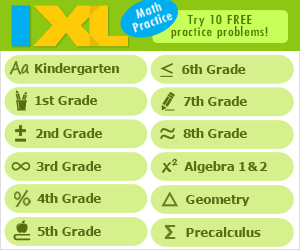4th Grade Geometry and Measurement
All links in the pages below were verified in November, 2011
To work on fourth grade geometry and measurement standards, click on the numbers below to visit pages with plenty of internet resources for each of the learning standards on the right.
Checks for Understanding are at the top of this page. Scroll down to find internet resources related to the State Performance Indicators (SPIs).
Checks for Understanding (Formative/Summative Assessment)
Circles - Identify the basic parts of circles. 0406.4.2 Degrees in Circle - Understand the definition of degree as it relates to the circle. 0406.4.3 Classify Angles - Classify angles and triangles as obtuse, acute, or right. 0406.4.4 Measure Angles - Measure and draw angles. 0406.4.5 Polygon - Determine if a figure is a polygon. 0406.4.6 Metric Measures - Recognize the use of decimals in metric measures. 0406.4.7 Measure Liquids - Measure liquids using both standard units and metric units. 0406.4.8 Area - Recognize that a measure of area represents the total number of same-sized units /that cover the shape without gaps or overlaps. 0406.4.9 Rearrange Figure - Recognize that area does not change when 2-dimensional figures are cut apart and rearranged. 0406.4.10 Rectangular Area Model - Connect area measure to multiplication using a rectangular area model. 0406.4.11 Estimate Area - Estimate areas of rectangles in square inches and square centimeters. 0406.4.12 Estimate Size - Estimate the size of an object with respect to a given measurement attribute (length, perimeter, area, or capacity). 0406.4.13 Compare Objects - Compare objects with respect to a given attribute such as length, area, and capacity. 0406.4.14 Coordinate System - Explain how the components of a coordinate system are used to determine location. 0406.4.15 Path Between Points - Explore properties of paths between points. 0406.4.16 Transformations - Examine transformations in the coordinate plane. 0406.4.17 Predict Results - Predict the results of a transformation of a geometric shape. 0406.4.18 Symmetry - Determine whether a geometric shape has line and/or rotational symmetry. 0406.4.19 Tilings and Tessellations - Design and analyze simple tilings and tessellations. 0406.4.20 Lines of Symmetry - Draw lines of symmetry in 2-dimensional figures. 0406.4.21 Faces of Shapes - Recognize two-dimensional faces of three-dimensional shapes.
State Performance Indicators
SPI 0406.4.1 Line Segments - Classify lines and line segments as parallel, perpendicular, or intersecting. SPI 0406.4.2 Quadrant I - Graph and interpret points with whole number or letter coordinates on grids or in the first quadrant of the coordinate plane. SPI 0406.4.3 Coordinate Grid - Construct geometric figures with vertices at points on a coordinate grid. SPI 0406.4.4 Identify Angles - Identify acute, obtuse, and right angles in 2-dimensional shapes. SPI 0406.4.5 Identify Attributes - Identify attributes of simple and compound figures composed of 2- and 3- dimensional shapes. SPI 0406.4.6 Accuracy - Determine situations in which a highly accurate measurement is important. SPI 0406.4.7 Appropriate Units - Determine appropriate size of unit of measurement in problem situations involving length, capacity or weight. SPI 0406.4.8 Convert Measurements - Convert measurements within a single system that are common in daily life (e.g., hours and minutes, inches and feet, centimeters and meters, quarts and gallons, liters and milliliters). SPI 0406.4.9 Area and Perimeter - Solve problems involving area and/or perimeter of rectangular figures. SPI 0406.4.10 Resulting Images - Identify images resulting from reflections, translations, or rotations
Search Internet4Classrooms

Custom Search






